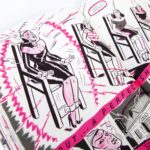
Prism Stalker #2
Creator: Sloane Leong
Cover Artist: Sloane Leong, Darius Ou
Review by Sean Frankling

You know what I love about comics? They so often tell the stories that are too weird for any other medium. Prism Stalker #2 is a perfect example of that weirdness in all its glory.
The series tells the story of Vep, a human in a thoroughly alien universe. Issue 1 introduced us to her life of service in the birthing chamber of another species’ hiveworld. Now, we see Vep spirited away to a mysterious interplanetary academy. The series is cagey about exactly what she’s been selected to study there, but the promotional copy may offer a hint. Apparently, Prism Stalker is “for fans of Octavia Butler, Sailor Moon, and the biopunk horror of David Cronenberg.” If that’s a hint that all this weirdness is leading up to a magical girl team, I cannot wait to see what it looks like.
The overwhelming strength of Prism Stalker #2 is in its portrayal of a world — or, well — several worlds designed without human comfort in mind. Environments incorporate unfamiliar geometries, unsettling organic structures and goopy, humid textures. By doing so, the art creates spaces that starkly emphasize the divide between human characters and their hostile surroundings. Likewise, it incorporates technology that interfaces with a character by causing hallucinatory body-horror or violating characters’ sinuses with creeping tendrils. The resulting visuals are surreal and unsettling — blurring the lines between literal reality and visual representations of Vep’s sensations.
Combining these elements with a near-total lack of exposition serves two purposes. First, of course, it creates a naturalistic and thoroughly believable picture of immersion in an alien culture. But by doing so, it also allows the creators to put their audience in the same headspace as poor Vep — disorientation, discomfort, and intense isolation.
Likewise, the behaviour of Vep’s alien classmates and the expectations on her as a student are incomprehensible. The story drops both her and the reader into a world of social conventions, motivations and duties without context. And when Vep finally does encounter another human face amidst all this, that shared experience allows the reader to feel every bit of her relief and excitement with her.
It’s a little early to say exactly what the series will do with all this brilliant theming. But so far, Vep’s forcible integration into an inhospitable world resembles narratives of refugee life and postcolonial theory. Prism Stalker #2 has built a powerful base to launch exploration of her experience navigating alien power structures.
It’s also worth noting the conspicuous lack of men among the few humans to appear in the series so far. This seems important, although its exact significance remains to be seen.
The Verdict: Buy it.
Some readers may find that the lack of exposition makes Prism Stalker #2 a frustrating read. But if you can hack it, it’s compelling, complex, and thematically rich — well worth your time.

![[COLUMN] QUARTERS DOWN #2: DISCOLORED](https://geekd-out.com/wp-content/uploads/2019/11/discolored2-150x150.jpg)

